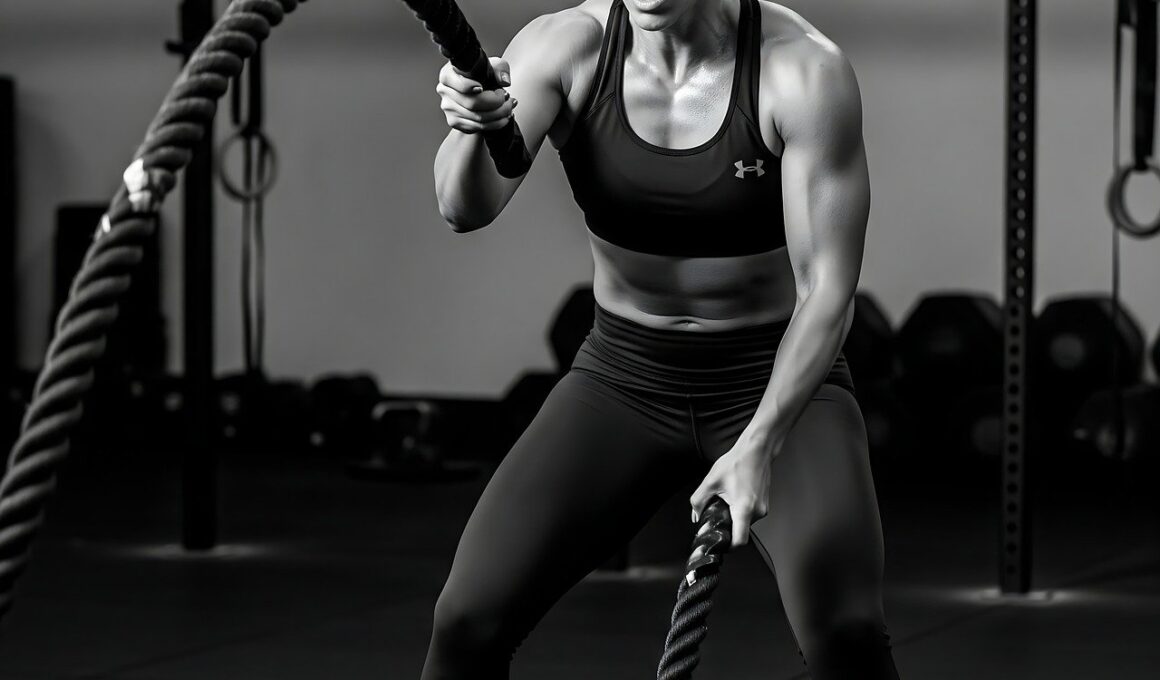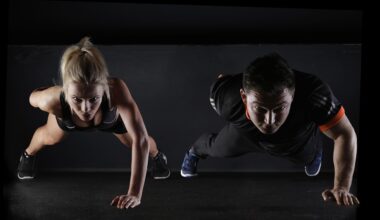Effect of High-Intensity Interval Training on Weight Maintenance for Athletes
High-Intensity Interval Training (HIIT) is rapidly becoming a favored modality for athletes aiming to maintain their weight. This approach integrates brief, intense bursts of exercise followed by recovery periods. One of the primary benefits of HIIT is its efficiency; sessions are often shorter while still yielding substantial results. Athletes engaged in HIIT often experience a boost in their metabolism, allowing for the burning of more calories even post-exercise. This afterburn effect, scientifically known as excess post-exercise oxygen consumption (EPOC), plays a crucial role in weight maintenance. Athletes appreciate how HIIT can fit seamlessly into their schedules as it requires less time than traditional steady-state cardio. Moreover, the versatility of HIIT makes it suitable for various sports disciplines. Through adaptability, athletes can modify intensity and duration according to their fitness levels and specific needs. Ultimately, incorporating HIIT can lead to improved body composition, efficiency, and athletic performance. It becomes evident that when managing weight, athletes should consider HIIT as an effective component of their regimen. Incorporating HIIT into a well-rounded fitness plan may optimize their performance and support weight management goals.
The advantages of HIIT are particularly appealing when considering calorie burn and time efficiency. Many athletes find traditional workouts mundane and time-consuming; HIIT offers an exciting alternative. With a focus on quick, powerful bursts, athletes can combat workout fatigue while achieving desired results. Furthermore, incorporating strength exercises into HIIT sessions can enhance muscle retention during weight loss. Athletes relying solely on steady-state cardio may find themselves losing muscle alongside fat. This can hinder performance, as strength is crucial in many sports. By integrating high-intensity intervals, athletes preserve lean muscle mass while shedding unnecessary pounds. This dual benefit of fat loss without sacrificing muscle can lead to a more athletic physique, which can be advantageous in competitions. HIIT is often more enjoyable, reducing dropouts from exercise routines. The fun comes from diversity, as workouts can be varied to avoid monotony. This aspect is crucial, as continued adherence to an exercise program is essential for long-term weight maintenance. Athletes should embrace the dynamic nature of HIIT to keep challenging themselves, leading to ongoing progress in their fitness journey while efficiently managing their weight.
HIIT Protocol Design
Designing an effective HIIT protocol is essential for athletes aiming for optimal weight maintenance. To maximize benefits, it is crucial to balance intensity, duration, and recovery times. Most HIIT workouts incorporate ratios of work to rest intervals, commonly ranging from 1:1 to 1:3, depending on fitness levels. Beginners may start with shorter bursts of high intensity, such as 20 seconds followed by a 40-second rest. As athletes adapt, they can progress to longer intervals and shorter rest periods. Incorporating various exercises, such as sprinting, cycling, or bodyweight movements, enhances engagement and targets different muscle groups. The total length of HIIT workouts can vary, generally spanning from 20 to 40 minutes. Additionally, athletes should engage in warm-up and cool-down activities to prevent injuries. Flexibility in choosing exercises allows athletes to focus on sports-specific skills or overall fitness. Monitoring heart rates during HIIT sessions can ensure the training remains within the desired intensity zones, aiding in the achievement of weight maintenance goals. Emphasizing proper technique throughout each exercise maximizes benefits and minimizes injury risk, promoting longevity in training and sustained athletic performance.
Nutrition plays a significant role when combining HIIT with weight maintenance. Athletes should fuel their bodies adequately to support the demands of high-intensity workouts. Consuming a balanced diet rich in macronutrients, particularly protein and carbohydrates, is vital. Protein aids in muscle recovery and preservation while carbohydrates provide necessary energy for intense efforts. Hydration is equally important, as dehydration can diminish performance and recovery. Following HIIT workouts, athletes should prioritize nutritional timing, consuming a balanced meal or snack within 30 minutes to support recovery and replenishment. This practice can help restore glycogen levels and promote muscle repair. Additionally, some athletes might consider consulting a sports nutritionist to create tailored meal plans that fit their training schedules. Understanding individual energy requirements based on training intensity and frequency is essential for optimizing performance and weight management. Mixing nutrient-dense foods also enhances energy levels and overall well-being. Athletes should strive for sustainable weight management strategies rather than quick fixes, focusing on creating healthy habits that align with their long-term performance goals. Implementing a strategic nutrition plan in tandem with HIIT can lead to success in weight maintenance and athletic endeavors.
Psychological Aspects of HIIT
Psychological benefits come hand-in-hand with regular participation in HIIT, significantly impacting athletes’ weight maintenance efforts. Engaging in HIIT can elevate mood levels, reduce stress, and enhance overall mental well-being. Regular intense physical activity stimulates the release of endorphins, often referred to as the body’s natural mood lifters. A positive mindset can foster a greater commitment to training and adherence to nutrition plans, essential components of weight management. Moreover, HIIT’s dynamic nature can combat workout boredom, ensuring athletes stay motivated and engaged. This psychological engagement can ultimately promote consistency in maintaining their weight goals. Additionally, setting and achieving specific HIIT performance targets can enhance athletes’ self-esteem and confidence in their capabilities. Visualization techniques might also be employed to reinforce mental resilience during high-intensity sessions. Cultivating a focus on personal growth and fitness can help athletes transcend challenges, ensuring a balanced approach to training and weight management. By recognizing the holistic impact of HIIT on mental health, athletes create a foundation for not only physical success but also emotional balance that supports sustained weight maintenance.
HIIT can also facilitate social connections, another vital aspect of psychological well-being. Group HIIT sessions encourage camaraderie among participants, fostering a supportive environment. These interactions can provide accountability, motivation, and shared experiences during training. Moreover, athletes may find themselves exchanging tips and strategies for weight maintenance within these social circles. The encouragement from peers can be incredibly impactful, particularly during challenging workouts or periods of lower motivation. Such positive reinforcement strengthens an athlete’s community ties, reducing feelings of isolation in their fitness journeys. In competitive scenarios, workout partners can inspire one another, pushing each other towards personal bests. These social dynamics not only enhance the enjoyment of exercise but also reinforce commitment to weight management goals. Taking part in team-oriented sessions can make weight maintenance feel less like a solitary endeavor and more like a collaborative effort. Ultimately, integrating social elements within HIIT routines can yield both physical and emotional improvements. Thus, athletes who seek to maintain their weight should consider the importance of building relationships and cultivating a thriving support network through their training efforts.
Conclusion and Recommendations
In conclusion, high-intensity interval training is an impactful and effective strategy for athletes seeking weight maintenance. Its versatility, efficiency, and numerous benefits make it an ideal choice for those aiming to manage their weight while enhancing performance. By carefully designing HIIT protocols, focusing on nutrition, and acknowledging the mental aspects of training, athletes can significantly benefit from integrating HIIT into their regimens. Finally, incorporating social connections within HIIT can offer additional accountability and support. For optimal outcomes, athletes should approach HIIT with an open mind, emphasizing personal growth, enjoyment, and performance goals. Ongoing evaluation and adjustments to training and nutrition plans maintain focus on long-term weight maintenance, helping athletes achieve sustainable success. Regardless of sports disciplines, athletes at all levels can harness the power of HIIT not just to maintain their weight but also to elevate their performance. Embracing consistency, progressive challenges, and enjoyment in workouts ensures continued growth. Following these recommendations fosters a healthy relationship with training, nutrition, and overall wellness. Ultimately, the intersection of fitness and mental resilience paves the way for lasting success in weight management for athletes across various domains.
Maintaining weight as an athlete is not merely about restricting food but involves a balanced fitness approach. It’s essential to embrace this strategy for lifelong health and performance. Combining HIIT with sensible nutrition, proper hydration, and social support amplifies motivation. Athletes should recognize that progress is gradual; being patient enhances effectiveness. This long-term perspective instills resilience against weight fluctuations. Incorporating techniques like keeping fitness journals can foster self-reflection and accountability. Such practices encourage ongoing commitment to HIIT and holistic well-being. When integrated thoughtfully, HIIT transcends traditional training, becoming a lifestyle choice that contributes to optimal weight maintenance. Athletes can take pride in their growth as they embrace the journey of fitness and health.


